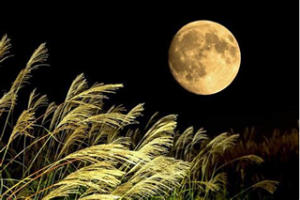Jugoya (September 29, 2023) and Juuzouya (October 27, 2023) ~Mid-Autumn Harvest Moon and Katsura Imperial Villa~
Yoshie Doi
 |
 |
The time when the moon shines most beautifully is around the Harvest Moon. The Harvest Moon in 2023 will be on September 29th. The day is different every year because it is determined based on the lunar calendar, which is based on the phases of the moon. In autumn, the moisture content of the air and the height of the moon are perfect conditions for humans to view the moon.
The Katsura Imperial Villa and Ginkakuji Temple, which were built to admire the moon, are open during the day, so we can’t see the moon, but once a year, a special Katsura Imperial Villa Moon Viewing Party is held.
Applications are now closed, so please apply next year. This year it will be held on Thirteenth Night (one month after the Harvest Moon).
The Thirteenth Night is a custom unique to Japan and is said to have started in the Heian period.
Mid-autumn means the middle of autumn. According to the lunar calendar, autumn was from July to September. Since the Heian period, aristocrats have started admiring the harvest moon, and Kyoto has many famous moon viewing spots. During the Edo period, people began offering offerings of potatoes and other items harvested during the harvest season to view the moon.
Nowadays, people eat tsukimi dango on the harvest moon, but in China they eat mooncakes.
Katsura Imperial Villa was built over 50 years during the Edo period in Katsura, which is said to be a famous place for the moon. There are many things related to the moon, such as the “Gepparou”, the moon viewing platform, the “Ukizuki” washbasin, the “Utatsuki” plaque, and the “Tsuki no ji” puller.
The moon viewing platform made of Takesunokohari that juts out from the Koshoin is designed so that the harvest moon is directly in front of it.
As the name suggests, Gepparou is a tea house built for viewing the moon. The attic is constructed to look like the bottom of a ship, making the teahouse itself look like a boat, giving you the feeling of looking at the moon from a boat.
We are amazed at the wisdom of those days when they were so good at astronomy. At the time of its construction, the water level of the Katsura River and the pond of the Katsura Imperial Villa were the same, and it seems that the moon could be viewed from the Katsura River by boat.
I have visited the Katsura Imperial Villa many times, and each time I visit, I am impressed by how the gardens were created to make nature appear as beautiful as possible.
Also, a long time ago I attended a moon viewing party at Ginkakuji Temple. At that time, the sky was cloudy so I couldn’t see the moon, but I was able to experience the splendor of Shoin, a garden for viewing the moon.
In the past, there were Japanese sweets shops that would give you pampas grass if you bought Tsukimi Dango. The reason pampas grass is displayed during moon viewing is because the sharp cut edges of pampas grass act as a talisman against evil spirits. The inside of the stem is hollow, and it was believed that the gods resided here. We decorate pampas grass with this meaning in mind.
Since ancient times, the Japanese have had a culture of not distinguishing between {things” and “heart.” We have come to realize that water, soil, and plants all have a “spirit.” It is also said that the Jomon people were able to talk to the soil, grass, and insects. I would like to have a conversation with the moon like the Jomon people.
Japanese people, who have a well-developed right brain, can hear the sounds of insects pleasantly, but to Westerners, they seem to hear nothing more than noise, making us wonder if we have different DNA. The culture of being close to nature may have taken root in Japan because of its unique DNA. I feel that astronomy was surprisingly advanced, such as Kitora’s astronomical maps and Abe Seimei’s astronomical maps of Daishogun Hachi Shrine. Although it was about 15 years ago, I vividly remember the excitement I felt when I saw it at Houmotsukan (treasure museum).
The Katsura Imperial Villa was built in the Edo period, so we take our hat off to the design that took into account the movements of the sun and moon. It is truly amazing that such knowledge existed even in an era when science was not yet developed. Is this the way to live in harmony with nature.
The end of document
